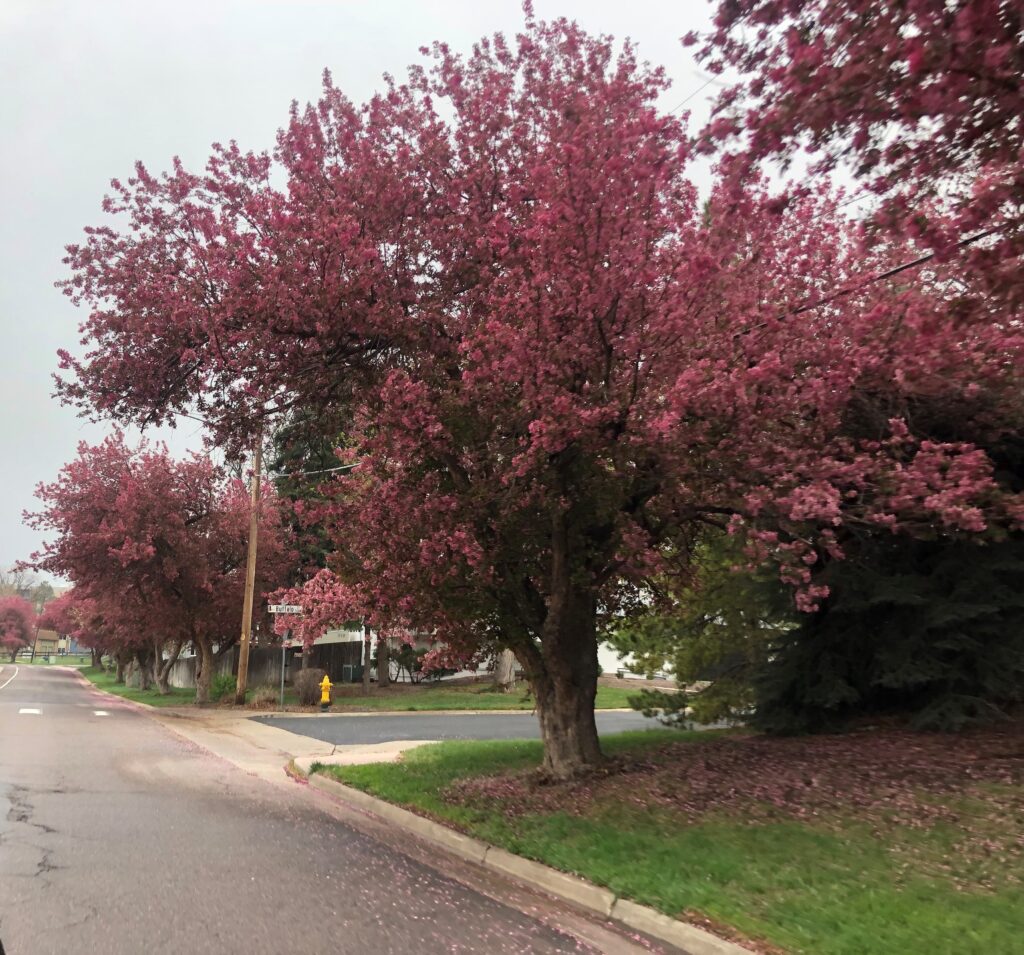From the Hort Desk
- 2024-05-02
- By mkirk
- Posted in Horticulture, The Garden Buzz
By Lisa Mason, CSU Extension Horticulture Specialist

Urban and Community Forestry: A Key to a Healthy and Sustainable Future
At CSU Extension and in the Colorado Master Gardener program, we often focus on individual tree care. We focus on supporting an individual tree’s health, best practices in planting, watering, the right plant in the right place, root care, pests, and diseases. Usually, the goal is to have a healthy tree that can provide benefits to the homeowner such as shade, aesthetics, privacy, wildlife habitat, and more.
Let’s look at the bigger picture. What happens when you have a mosaic of hundreds to thousands of trees in an urban landscape? TREE-mendous things!
Each individual tree is a puzzle piece to the greater picture of our urban forests. “Urban forests are a component of green infrastructure, and they are a dynamic part of the urban ecosystems with interconnected social, economic, and ecological components,” said Dana Coelho, Urban & Community Forester Program Manager for the USDA Forest Service.

Arapahoe County Master Gardeners recently had the opportunity to learn more about the importance of our urban and community forests at the Arapahoe County Spring Kick-Off Meeting. Coelho spoke about the benefits of urban forests and what it’s like to manage them.
Urban forests in our neighborhoods and communities provide a variety of benefits for people and the ecosystem including:
- Clean air and water
- Shade and reduced energy consumption
- Reduced temperatures from the urban heat island effect
- Lower rates of noise pollution
- Increased property values
- Wildlife habitat
- Reduced stormwater runoff and erosion
- Lower crime rates
- Aesthetically pleasing landscapes
- Enhanced recreational opportunities
- Mental and physical health benefits for people
- And more.
Read more about the research documenting the myriad of beneficial impacts that urban forests have on people and communities in the Urban Nature for Human Health and Well-being by the USDA Forest Service.
Managing Urban Forests
Long-term care for urban forests consists of assessment, planning and management. Assessing urban forests helps us understand the trees that already exist. Tree inventories, canopy assessments and calculating ecosystem services are all tools included in the assessment process. Planning for urban forests consists of developing goals, strategies, objectives and actions in line with values, policies and budgets. Plans should include monitoring and evaluation to improve management. “The time frame of our plans matters. Short-range plans simply don’t cut it in urban forestry. Trees, like humans, are long-lived beings if properly tended to. Rushing ahead with tree planting without adequate knowledge and standards guiding proper planting, establishment, and care can lead to a lot of wasted time and resources,” said Coelho. Managing urban forests puts the plan into action and includes planting, establishing, maintaining, removing, reusing and repeating.
One of the priorities in managing urban forests is understanding tree equity across the landscape. Tree equity combines data on the tree canopy within an area, along with social and economic community data. Tree canopy cover is often much lower in underserved communities, meaning that not everyone receives the same benefits. “In Denver and along the Front Range, we see relatively high equity scores overall, but a closer look reveals neighborhood-level inequity. Again, this means that not all people within a city have the same level of access to tree canopy, to nature, and to the benefits these natural resources provide for their physical, mental, social, and economic well-being,” said Coelho.
What Can You Do to Support Urban Forests in Your Community?
Everyone in the community has a role in supporting the care of urban forests, from individuals, volunteers, local, state, and federal government agencies, non-profits, tree and landscape care companies, businesses, and more. Here are some ways you can support urban forests:
- Maintain the health of the trees in your home and community landscape.
- Provide supplemental water to your trees all year around when we have periods of no precipitation.
- Support root health by adding mulch around the tree and avoiding root compaction.
- Plant and care for new trees using best practices.
- Share educational resources with your HOA on tree care and management.
- Consider planting a diversity of tree species in the landscape. The Front Range Recommended Tree List is now updated and available. Remember right plant, right place.
- Remember to prioritize water for your trees when doing turf removal, xeric or water-wise landscaping, or any type of landscape conversion.
- Observe your surroundings, learn to identify trees, look for pests such as emerald ash borer, an invasive species threatening all ash trees.
- Keep learning—check out the following:
- Call the Arapahoe County Extension Office and ask master gardeners questions about your trees.
- Enjoy all the benefits that trees offer. Spend time outdoors or go for a walk. Hug a tree!
Horticulture Resources
- Garden Buzz Archives
- CSU Extension Resources
- Colorado Master Gardener Program
- Foothills to Plains Native Plant Master Program
- Native Bee Watch Community Science Program
- The Co-Hort Blog
- PlantTalk Colorado
- Soil Testing
- Plant Select
- Emerald Ash Borer
- Japanese Beetle
- Colorado State Forest Service
- Ask an Expert


